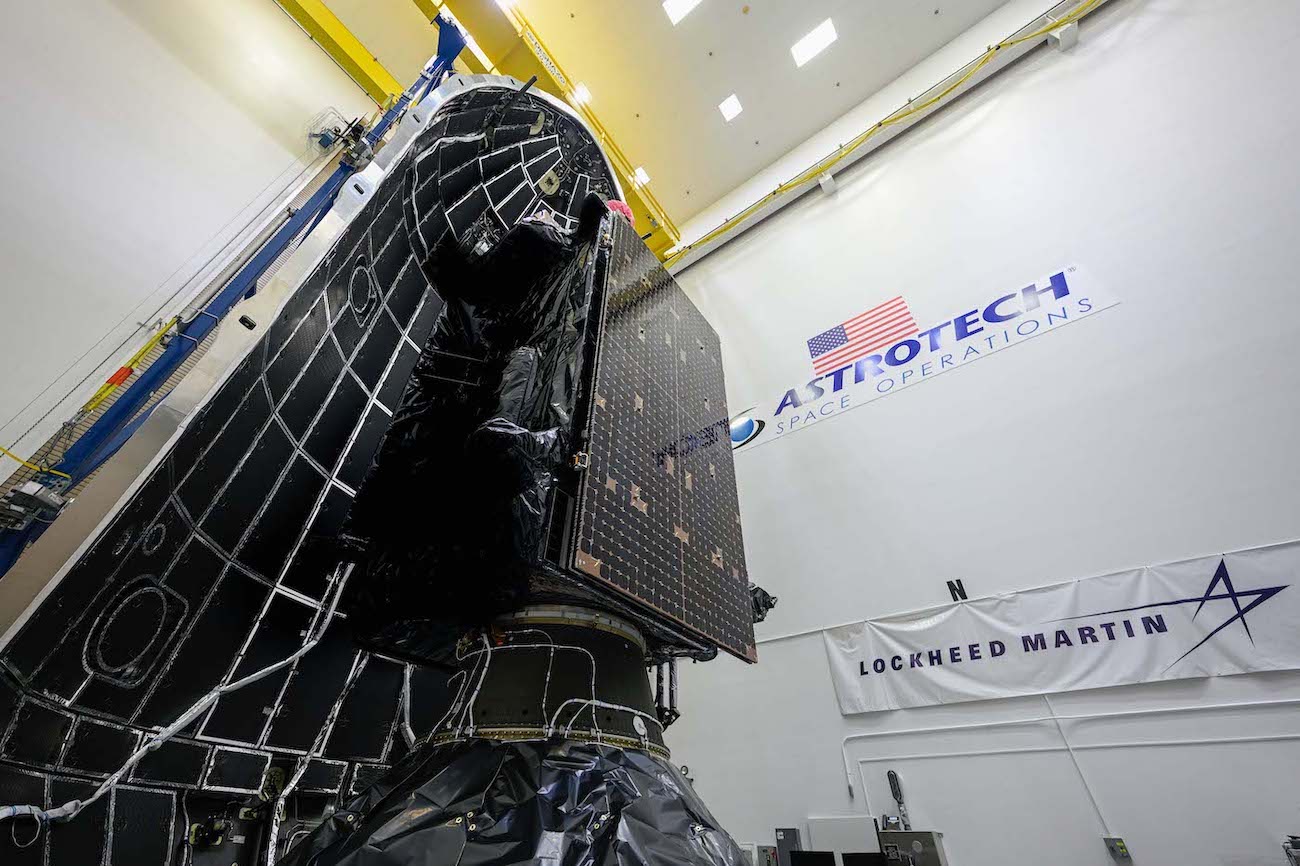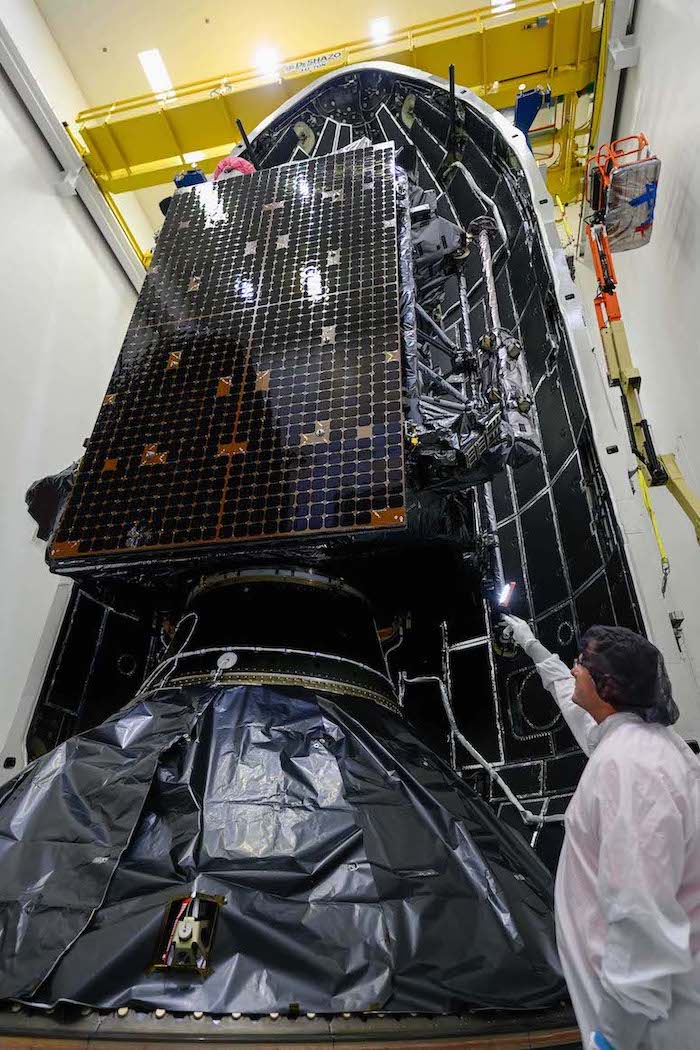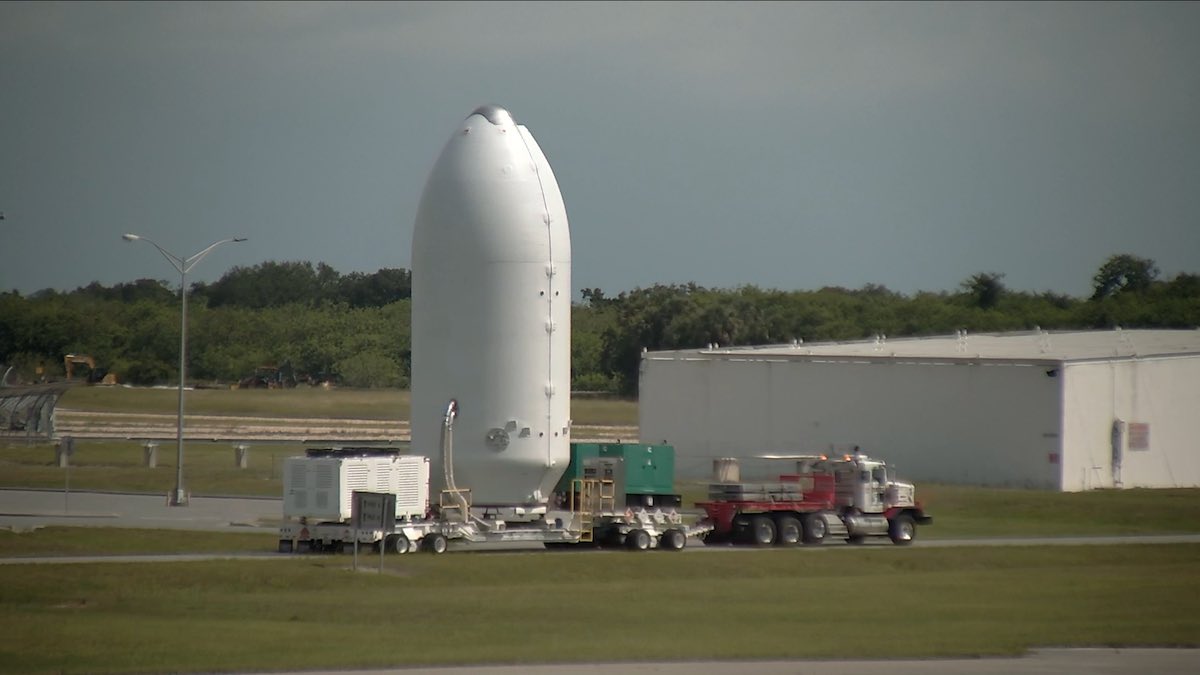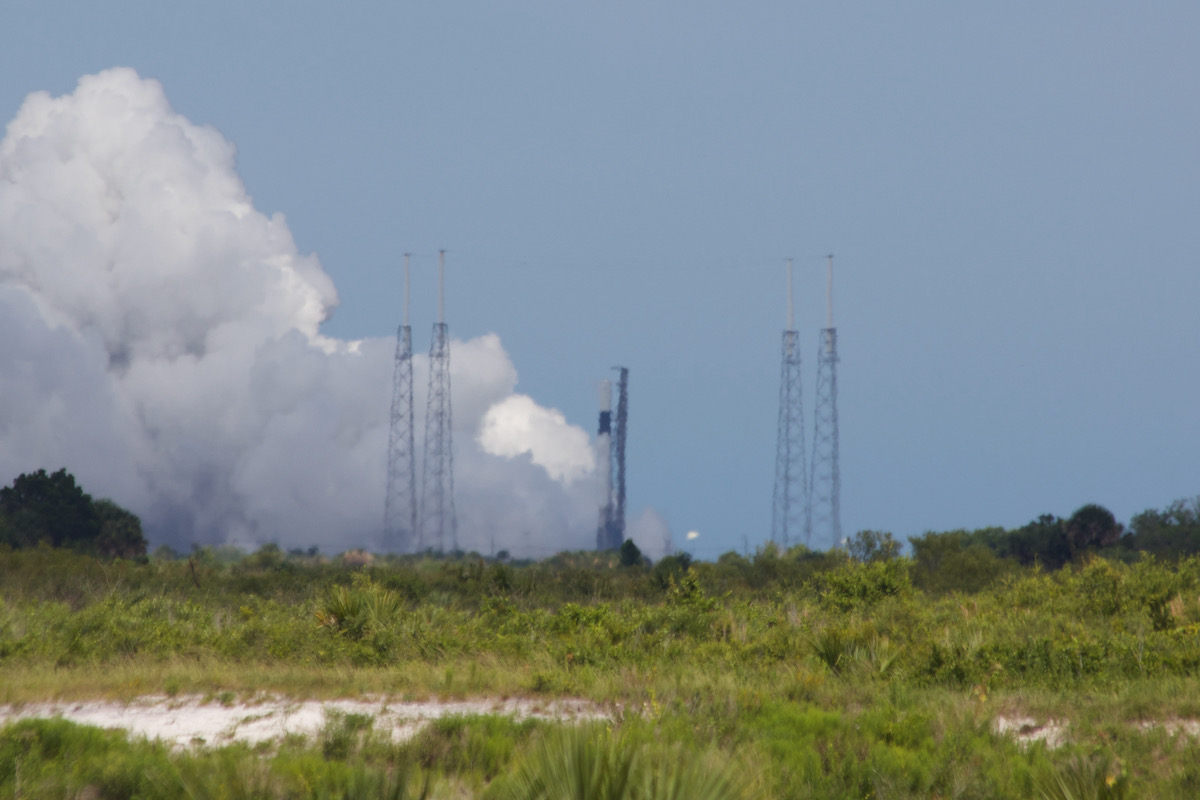
Following years of planning, a GPS navigation satellite built by Lockheed Martin will be the first operational U.S. military payload to ride a reused SpaceX booster on a launch from Florida Thursday, laying the groundwork for future national security missions to save money by incorporating recycled rocket parts.
SpaceX has launched 66 reused boosters with a flawless success record since March 2017. But the launch Thursday from Cape Canaveral Space Force Station will be the first time military officials have entrusted a high-priority national security payload with a ride on a reused first stage.
The certification of reused Falcon 9 boosters for national security payloads could save taxpayers hundreds of millions of dollars in the next few years. It has already resulted in $64 million in savings on a contract covering multiple GPS launches, including the mission set for liftoff Thursday.
“In preparation for this first-time event, we’ve worked closely with SpaceX understand the refurbishment processes and are confident that this rocket is ready for its next flight,” said Walter Lauderdale, the deputy mission director and Falcon division chief at the Space Force’s Space and Missile Systems Center.
The Global Positioning System satellite set for launch Thursday is the fifth in the latest generation of GPS spacecraft. Designated GPS 3 SV05, and nicknamed “Neil Armstrong,” the satellite is closed up inside the Falcon 9 rocket’s payload fairing awaiting launch.
It will join 31 operational GPS satellites orbiting about 12,550 miles (20,200 kilometers) above Earth providing positioning, navigation, and timing signals to billions of users around the world.
Liftoff is scheduled for 12:09:35 p.m. EDT (1609:35 GMT) Thursday from pad 40 at Cape Canaveral Space Force Station in Florida. The launch window Thursday extends for 15 minutes.
The weather forecast is iffy, however, with a 70% chance of acceptable conditions for liftoff and a moderate risk of unfavorable upper level winds. The main weather concerns Thursday are with potential cumulus clouds and lightning in the area.
The first stage booster set to liftoff Thursday flew for the first time last November on the launch of the most recent GPS mission, when it landed on an offshore drone ship. Before that mission, military officials said the rocket would be reused on the next GPS launch.
Lauderdale said the military has been working since 2016 on certifying the use of reused rocket hardware on national security satellite launches. SpaceX and United Launch Alliance, the Space Force’s two primary space launch providers, can propose to use previously-flown hardware on all national security missions under new contracts awarded last August.
But the Space Force agreed to begin launching GPS missions on reused rockets earlier than planned. The military and SpaceX amended existing contracts to make the change to allow for recovery of the Falcon 9 booster on four GPS missions, and the reuse of the booster on two launches, reducing SpaceX’s charge to the government by $64 million.
“Through continued partnership with SpaceX, we were able to reach an agreement to accelerate our use of previously-flown hardware for GPS missions,” Lauderdale told reporters in a teleconference Monday.

SpaceX has flown one of the Falcon 9 boosters in its fleet 10 times, and several others have completed five or more missions.
A military launch in 2019 of a Falcon Heavy rocket, which SpaceX created by bolting together three Falcon 9 cores, used two previously-flown side boosters. But that mission carried experimental technology demonstration satellites, not an operational payload like a GPS spacecraft.
Since agreeing to put the GPS 3 SV05 spacecraft on a reused booster, the Space Force formally certified SpaceX’s recovery and refurbishment processes. That non-recurring work will make it easier to regularly fly national security payloads on reused Falcon 9s in the future, Lauderdale said.
Technicians with the 5th Space Launch Squadron at Cape Canaveral follow SpaceX’s refurbishment of reused rockets. Compared to many commercial satellite operators, the Space Force performs additional oversight of its launch contractors due to the high cost and criticality of its payloads for U.S. national security.
“Working with SpaceX, we evaluate their inspection processes as well as what they have done to evaluate the hardware after it returns,” Lauderdale said.
The work included establishing how to evaluate the remaining life of a Falcon 9 booster by analyzing the stress it encounters during launch and re-entry back into the atmosphere. SpaceX’s busy launch schedule — this will be the 19th Falcon 9 launch of the year — has given military officials plenty of data to crunch, and added to their confidence in launching the GPS 3 SV05 spacecraft on a reused booster.
“We evaluate all of that and compare that, in essence, to see how much of the life of any other components may have been consumed by what it’s seen during flight,” Lauderdale said. “So that flight data has been very helpful for us in assessing how much life is remaining.
The Space Force “will continue to evaluate that data as we look at potential for going beyond the second flight of a particular booster,” he said.
Lauderdale said the launch Thursday will use a brand new payload fairing, which protects the satellite during launch. He said SpaceX could propose reusing the nose cone on future national security missions.

The GPS 3 SV05 satellite arrived on Florida’s Space Coast in April from its Lockheed Martin factory in Colorado. After delivery on an Air Force C-5 cargo plane, the spacecraft passed final checkouts and was fueled with hydrazine and nitrogen tetroxide maneuvering propellants.
The fully fueled satellite weighs approximately 9,550 pounds, or 4,331 kilograms, according to Col. Edward Byrne, senior materiel leader for Medium Earth Orbit systems at SMC.
Technicians encapsulated the spacecraft inside SpaceX’s payload fairing June 9 at the commercial Astrotech payload processing facility in Titusville.
Meanwhile, SpaceX ground crews at pad 40 rolled the Falcon 9 rocket to its launch mount and raised it vertical for a brief test-firing Saturday. After the static fire test, SpaceX returned the rocket to its hangar a quarter-mile away for connection with the GPS 3 SV05 spacecraft and its payload shroud.
The satellite and payload fairing traveled by truck from the Astrotech processing facility to the pad 40 hangar Sunday.
SpaceX will transfer the fully-assembled rocket back to pad 40 and raise it upright again ahead of Thursday’s countdown.
Three of the Space Force’s first four new-generation GPS 3-series navigation satellites have launched on Falcon 9 rockets from SpaceX. Another GPS 3 satellite lifted off on Delta 4 rocket from SpaceX rival United Launch Alliance.
The upgraded series of GPS 3 navigation satellites are designed for 15-year life spans, an improvement over the seven-and-a-half year and 12-year design lives of previous-generation GPS satellites.
Th GPS 3 satellites provide three times better accuracy and up to eight times improved anti-jamming capabilities over early GPS spacecraft, according to Lockheed Martin.
The GPS 3 satellites also introduce a new L-band civilian signal that is compatible with other international navigation satellite networks, such as Europe’s Galileo program. Combining signals from GPS, Galileo, and other navigation satellites can improve the precision of space-based position measurements.
The U.S. military uses GPS satellites for smart bombs and other precision-guided munitions. Troops rely on the network, which requires a minimum of 24 satellites for global coverage, to provide positioning data pole-to-pole.
With GPS 3 SV05, the GPS fleet with have 24 satellites capable of beaming an encrypted military-grade navigation signal known as M-code, enough for worldwide M-code coverage. The oldest GPS satellites still in the fleet are not outfitted with M-code.
The M-code signal allows GPS satellites to broadcast higher-power, jam-resistant signals over specific regions, such as a military theater or battlefield. The capability provides U.S. and allied forces with more reliable navigation services, and could also allow the military to intentionally disrupt or jam civilian-grade GPS signals in a particular region, while the M-code signal remains unimpeded.
L3Harris Technologies builds the navigation payloads for the GPS 3 satellites.
Civilians use the Global Positioning System on their smartphones, and airliners employ augmented GPS signals for precision landings and in-flight navigation. Banks use the timing signals from GPS satellites to time tag financial transactions.
Byrne said Monday that the GPS 3 SV05 satellite will operate in Plane D, Slot 1, of the GPS constellation. That position is currently occupied by a GPS satellite that launched from Cape Canaveral on Nov. 6, 2004, on a Delta 2 rocket.

On Thursday’s mission, SpaceX’s Falcon 9 rocket will head northeast from Cape Canaveral to align with an orbital plane in the GPS fleet inclined at 55 degrees to the equator.
The rocket’s nine Merlin 1D first stage engines will fire for about two-and-a-half minutes before shutting down, allowing the booster to separate and begin descending back to SpaceX’s drone ship “Just Read the Instructions” in the Atlantic Ocean.
A second stage engine will fire two times to inject the GPS satellite into an elongated orbit with its highest point, or apogee, near the GPS network’s operating altitude of 12,550 miles.
Deployment of the GPS 3 SV05 spacecraft from the Falcon 9’s upper stage is expected about 90 minutes after liftoff.
The Falcon 9’s first stage, meanwhile, will land on the drone ship about eight-and-half minutes into the mission. The vessel will return to Port Canaveral with the rocket, which will be refurbished for another launch.
Lauderdale said the booster will return to SpaceX’s rotation of reused rockets for use on commercial missions. The Space Force’s next GPS launch in 2022 will use a different previously-flown Falcon 9 rocket.
Email the author.
Follow Stephen Clark on Twitter: @StephenClark1.
